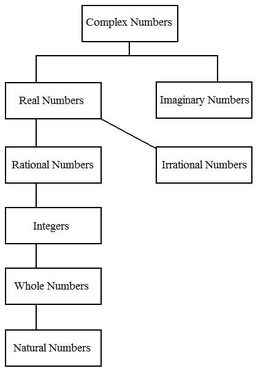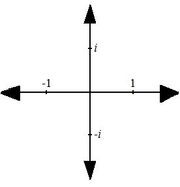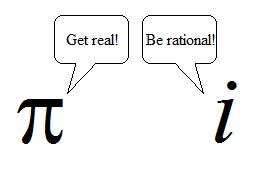
A simplified "tree" of number systems.
Number systems are numbers grouped in specific areas of mathematics. All numbers we work with, both real and imaginary, are complex.
Complex numbers are divided into real and imaginary numbers. Real numbers then branch out into rational and irrational numbers. Rational numbers branch into integers, then integers branch into whole numbers, and whole numbers branch into natural numbers. This page will discuss all categories aforementioned.
Real and Imaginary Numbers[]

In a coordinate plane, think of the x-axis representing real numbers and the y-axis representing imaginary numbers.
Real Numbers[]
Real numbers are numbers that do not involve i, the function for imaginary numbers. Examples of real numbers are 3, -8, e, and .
Imaginary Numbers[]
Further reading: Imaginary Numbers
Imaginary numbers involve integers and i.
Imaginary numbers cannot be broken down any further, so it is its own little stub of a branch on the tree of complex numbers. How sad.
Rational and Irrational Numbers[]

A clever joke involving and i.
Rational Numbers[]
Rational numbers either repeat or terminate in decimals. They can each be expressed as a fraction.
Irrational Numbers[]
Irrational numbers neither repeat nor terminate. They cannot be expressed as a fraction. Most of the real numbers are irrational.
Irrational numbers cannot be broken down any further, so it is its own branch of the complex number tree. Again, how sad.
Integers[]
Refer to the coordinate plane. For integers, imagine the x-axis alone. That is a number line, the best way to depict integers.
Integers include negative numbers, zero, and positive numbers.
Whole Numbers[]
Whole numbers do not include negative numbers. Sorry, .
Natural Numbers[]
Natural numbers are the numbers you usually count with. Zero is omitted in the natural number system. Sorry, 0.






![{\displaystyle {\sqrt[{3}]{-216}}\,=-6}](https://services.fandom.com/mathoid-facade/v1/media/math/render/svg/8a6e7f3e1c93f466b6fb970268d50d7f35704675)
![{\displaystyle {\sqrt[{3}]{216}}\,=6}](https://services.fandom.com/mathoid-facade/v1/media/math/render/svg/db3b037037fe32b0f6a2069fc4308ba7dc580b3a)





